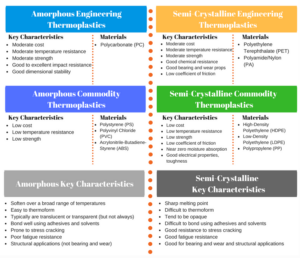Plastic is a widely used material in manufacturing, both in products and packaging. It is energy efficient and relatively easy to manufacture in comparison to alternatives. However, there are countless different types of plastics that are used in different types of application. In general, plastics can be grouped into two main families: thermoplastics and thermosets. The main difference between these two types of polymers is that thermoplastics soften and become pliable above specific temperatures (upon heating) and solidify again upon cooling, whereas thermosets always remain in a permanent solid state once they have been molded. Today we will look at the thermoplastic group.
Here’s a look at some of the most commonly used types of plastic:
HDPE is one of the most commonly used types of plastic. Its simple chemical structure makes it easy to produce and is therefore widely used for various low value applications. There are multiple types of polyethylene and HDPE is a relatively stronger, thicker form. It can be made pigmented or unpigmented. Unpigmented is naturally translucent and has good barrier properties and stiffness, but pigmented has better stress crack resistance. HDPE also has good chemical resistance, permeability to gas, and resistance to moisture.
This stiff plastic is often used for more robust products or packaging such as detergent and shampoo containers, or opaque milk, and juice containers, as well as folding chairs and tables, piping, Tyvek, and storage sheds, for example.
Low Density Polyethylene (LDPE):
PET might be the most widely produced plastic in the world. It is a colorless tough resin that is a great barrier to gases (such as oxygen and carbon dioxide) and liquid (water, etc.). Along with its visually smooth surface, it has strength, high impact capability, and shatter resistance. PET has wide application use. Because of its strong ability as a liquid and gas barrier, it is popular for food and drink packaging. You may have also heard of PET in its fiber form, commonly known as Polyester.
Polypropylene (PP):
This resin is strong, with good chemical resistance and a high melting point. It is semi-transparent with a low-friction surface, and is adaptable to a variety of manufacturing techniques due to its simple chemical structure. PP is used for similar applications as polyethylenes, but is generally stiffer and more heat resistant. Its crystallinity (relating to hardness & density) is quite high, landing somewhere between that of LDPE and HDPE. PP works well for electrical resistance and insulation. It is often used in producing plastic automotive parts, consumer product packaging, textiles, hot food containers, as well as for plastic moldings in which complex shapes can be formed at relatively low cost and high volume.
Polystyrene (PS):

Polycarbonates are another group of thermoplastics that contain carbonate groups in their structure. Although it is a thermoplastic that is easily molded, it is stronger than some and will hold up longer to extreme temperatures. It also has relatively high impact strength, however it has low scratch resistance, which makes it necessary to add another hard coating when utilizing the material for things such as eye glass lenses or exterior car parts. Polycarbonate is a very transparent material, which combined with its strength makes it a popular choice for consumer products needing to be shatter-proof and also for epoxy resins.
Originally the material was developed to be an alternative to die-cast metal or sheet metal to be beneficial for applications where parts that are transparent or don’t conduct electricity are needed. The ability for polycarbonate to be formed or bent without breaking or cracking allows it to work well as an alternative. However, in recent years there have been toxicity concerns revolving around certain applications of PC due to the presence of bisphenol A (BPA), which can leach from polycarbonate. Polycarbonate is still utilized in a variety of product types such as water bottles, eye glass lenses, CDs/DVDs, housing for some electronics, riot gear for police, snowboards, car parts, and more.


